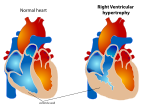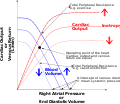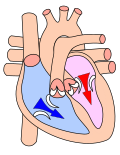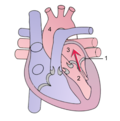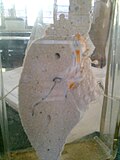Afterload is the pressure that the heart must work against to eject blood during systole (ventricular contraction). Afterload is proportional to the average...
11 KB (1,301 words) - 16:39, 22 June 2024
Stroke volume (section Preload and afterload)
individuals, but increased afterload will hinder the ventricles in ejecting blood, causing reduced stroke volume. Increased afterload may be found in aortic...
7 KB (881 words) - 03:28, 10 September 2024
against LV volume at multiple time points during a single cardiac cycle. Afterload is the mean tension produced by a chamber of the heart in order to contract...
21 KB (2,725 words) - 00:39, 4 July 2024
systemic vascular resistance results in an increase in afterload. With HOCM, an increase in afterload will hold the obstruction in a more open configuration...
24 KB (2,934 words) - 12:43, 30 May 2024
Cardiac physiology (section Afterload)
This tension is called afterload. When the resistance is increased particularly due to stenotic valve damage the afterload must necessarily increase...
47 KB (5,787 words) - 15:46, 21 August 2024
myocardial contractility increases with afterload. It was experimentally determined that increasing afterload caused a proportional linear increase in...
4 KB (474 words) - 00:06, 15 August 2023
Disease processes that can cause LVH include any disease that increases the afterload that the heart has to contract against, and some primary diseases of the...
16 KB (1,447 words) - 20:14, 13 July 2024
myocardial oxygen perfusion and indirectly increases cardiac output through afterload reduction. It consists of a cylindrical polyurethane balloon that sits...
9 KB (984 words) - 17:17, 29 November 2023
Conduction velocity Preload Afterload Contractility By this model, if myocardial performance changes while preload, afterload, heart rate, and conduction...
7 KB (857 words) - 07:57, 4 May 2024
affects diastolic relaxation. Many positive inotropes affect preload and afterload. Most Adrenergic agonists Atropine Dopamine Epinephrine Isoproterenol...
3 KB (286 words) - 17:41, 30 March 2024
resistance. Vasodilation acts to increase cardiac output by decreasing afterload, −one of the four determinants of cardiac output. By expanding available...
44 KB (4,094 words) - 00:00, 8 August 2024
vascular dilatory effects of the drug lead to a decreased preload and afterload, putting less work on the heart. This drug is in the process of review...
9 KB (809 words) - 00:50, 5 June 2024
physiology terms for the hemodynamic modulators are preload, contractility and afterload. They deal with (a) the inertial filling forces of blood return into the...
20 KB (2,159 words) - 00:32, 19 August 2023
cardiac cycle. The main factors that affect the end-systolic volume are afterload and the contractility of the heart. End systolic volume can be used clinically...
2 KB (336 words) - 15:46, 22 June 2024
handgrip maneuver increases afterload by squeezing the arterioles and increasing total peripheral resistance. Since increasing afterload will prevent blood from...
5 KB (422 words) - 05:21, 26 October 2023
cardiac muscle in which it has to contract while experiencing an excessive afterload. Pressure overload may affect any of the four chambers of the heart, though...
3 KB (280 words) - 14:11, 17 March 2021
in preload, while shifts from one line to another indicate a change in afterload or contractility. A blood volume increase would cause a shift along the...
17 KB (1,928 words) - 04:53, 28 August 2024
administration results in a decrease in total peripheral resistance (afterload) and cardiac venous return (preload). All of the physiological effects...
41 KB (3,269 words) - 22:06, 30 August 2024
peripheral vessels, respectively, which reduces peripheral resistance and afterload, though not as potent as the dihydropyridine (DHP) calcium channel blockers...
25 KB (2,273 words) - 10:08, 3 August 2024
output and peripheral resistance, with relatively low blood pressure, the afterload on the heart decreases; this decreases how hard the heart must work to...
29 KB (3,270 words) - 15:49, 13 July 2024
blood shift, and the increasing resistance to left ventricular ejection (afterload) by rising blood pressure. Other changes commonly measured in the electrocardiogram...
22 KB (2,398 words) - 09:36, 30 July 2024
resistance in the placental circulation, causing an increase in cardiac afterload. There is also increased vasoconstriction of the arteries in the periphery...
40 KB (4,410 words) - 14:51, 6 September 2024
step-wise approach, with the physiologic goal of optimizing cardiac preload, afterload, and contractility. It includes giving early antibiotics. EGDT also involves...
124 KB (13,422 words) - 01:47, 30 August 2024
natriuresis. This consequently may lead to a reduction in preload and afterload, thereby alleviating cardiac workload and improving left ventricular function...
53 KB (4,947 words) - 11:31, 2 September 2024
available seat miles of a particular transportation operation (e.g. a flight) Afterload, the maximum effect of a heartbeat driving blood mass out of the heart...
3 KB (498 words) - 23:04, 20 May 2024
resistance to blood flow through systemic arterioles, which decreases afterload (decreases the failing heart's workload) and reduces the amount of mitral...
14 KB (1,266 words) - 17:48, 27 July 2024
cannot flow backwards and therefore blood is “milked” towards the heart. Afterload Cardiac output Frank–Starling law of the heart Passive leg raising test...
6 KB (716 words) - 16:20, 22 June 2024
Milrinone also works to vasodilate which helps alleviate increased pressures (afterload) on the heart, thus improving its pumping action. While it has been used...
15 KB (1,490 words) - 04:22, 18 September 2024
acute MR is normotensive, vasodilators may be of use to decrease the afterload seen by the left ventricle and thereby decrease the regurgitant fraction...
35 KB (3,728 words) - 08:09, 15 July 2024
Vasodilators are increased (such as nitric oxide and carbon monoxide) reducing afterload with compensatory increase in cardiac output, mixed venous oxygen saturation...
115 KB (11,933 words) - 22:14, 8 September 2024






